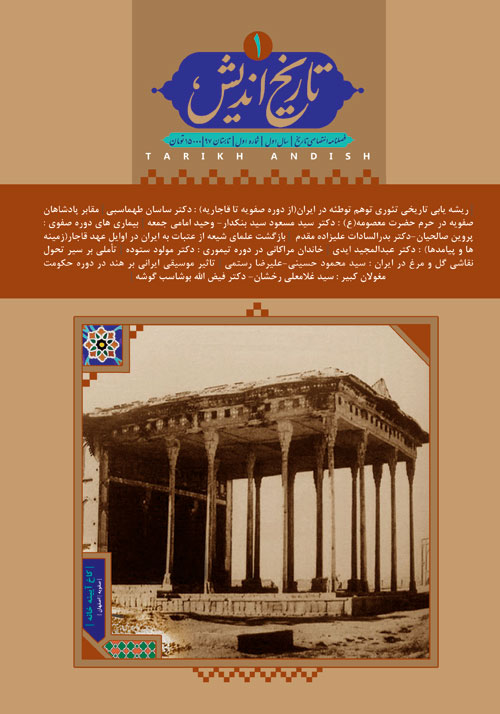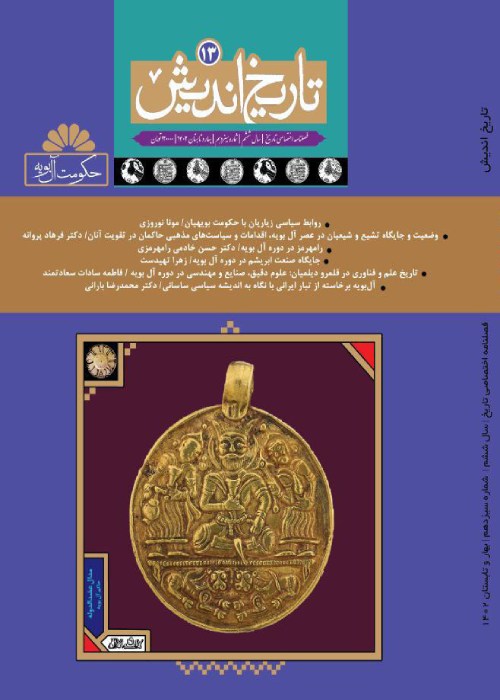فهرست مطالب

نشریه تاریخ اندیش
پیاپی 1 (تابستان 1397)
- تاریخ انتشار: 1397/05/20
- تعداد عناوین: 8
- سرسخن
-
صفحه 4
-
صفحات 21-46
پس از عزیمت امام هشتم شیعیان به خراسان گروه زیادی از علویان و خاندان آن حضرت به جهت دیدار امام عازم خراسان گردیدند. یکی از این افراد حضرت فاطمه معصومه (ع)، خواهر حضرت امام رضا(ع)، بود. در جریان سفر، حضرت معصومه در قم بیمار شده و در سال 201 هجری قمری در این شهر وفات یافت. با گذشت زمان مزار مطهر ایشان مبدل به یکی از زیارتگاه های شیعیان و مرکز تجمع آنان گردید. با رسمی شدن مذهب تشیع در ایران عصر صفوی و توجه بیش از پیش پادشاهان این سلسله به مراقد ائمهی شیعه و امامزادگان، بر اهمیت این مراکز افزوده گردید. شهر قم بهواسطهی وجود حرم حضرت معصومه (ع) یکی از این مراکزی بود که مورد توجه پادشاهان صفویه قرار گرفت و در طول حکمرانی این سلسله اقدامات گوناگون عمرانی در حرم مطهر صورت پذیرفت. از آنجا که قدرت خاندان صفویه از میان خانقاه شیخ صفی الدین اردبیلی برخواسته بود و آنان خود را به عنوان مرشد کامل و رهبر طریقت صفویه معرفی مینمودند، در آن دوره خانقاه و مقبرهی خاندان صفویه بهمانند یکی از مهمترین اماکن مقدس به شمار میرفت. به طوری که موسس این سلسله، شاه اسماعیل اول، در این مقبرهی خاندانی به خاک سپردهشد. اما خطری که میتوانست پیوسته این مجموعه را تهدید کند، خطر تهاجم دشمن اصلی صفویان، امپراتوری عثمانی، بود. با درگذشت شاه طهماسباول، پیکر او به حرم مطهر حضرت امام رضا (ع)، در مشهد، انتقال دادهشد. اما این مکان نیز تا مدتها مورد هجوم و تعرض دشمنان شرقی صفویان، ازبکان، قرار میگرفت. بهگونهای که در حملهی ازبکها به فرماندهی عبدالمومن خان ازبک به خراسان و تعرض آنان به حرم مطهر امام رضا در سال 1004هجری قمری، مقبرهی شاه طهماسب نیز مورد بیحرمتی قرار گرفت (ترکمان، 1382: ج2/ 527). به این واسطه خاطرهی این اتفاق بعدها باعث گردید که سایر سلاطین صفوی، مناطق مرکزی را برای محل تدفین خود تعیین نمایند. برای نمونه، پس از درگذشت شاه عباس اول، بازماندگان او از بیم هتک حرمت به جنازهی او، شش تا دوازده تابوت آماده کردند تا هرکدام را به یکی از شهرهای مقدس بفرستند تا برای کسی مشخص نباشد که جنازهی او دقیقا در کجا دفن می شود (شاردن، 1372: ج2/ 531). اما بهواسطهی نوشته های اسکندربیگ ترکمان که از نزدیکان شاه عباس بهشمار میرفت، مشخص میگردد که جنازهی شاه در امامزاده حبیببنموسی در کاشان به امانتگذاردهشد تا بعدها به یکی از مشاهد متبرکه انتقال یابد که این امر نیز محقق نگردید (ترکمان، 1382: ج3/ 1079). پس از شاه عباس اول، نظر به موقعیت قرارگیری شهر قم در مرکزیت ایران کلیهی پادشاهان پس از وی، در حرم حضرت معصومه دفن گردیدند و بهواسطهی قرار گرفتن مقابر پادشاهان در حرم حضرت معصومه، بناها و آثار ارزشمند دیگری به مجموعهی حرم مطهر اضافه گردید.
کلیدواژگان: مقابر، پادشاهان، صفویه، قم، حرم حضرت معصومه -
صفحات 49-67
-
صفحات 85-112
-
صفحات 115-128
-
صفحات 131-147
-
Page 4Although in the Safavid period there a mainly friendly relationship between Iran and Europe, there was a constant suspicion toward the Europeans. The suspicion was the result of various factors. Lack of information about Europe, the Europeans’ enjoyment with sophisticated weapon and warships, the propagandas of the Christian missionaries and the Europeans companies’ profiteering caused a constant doubt about their real aims. As a result, all of the Europeans, even the ambassadors were subject to the allegation of spying and conspiracy. As time went, mistrust and suspicions intensified and when the decline of the Safavid Ottoman governments revealed, the anxiety became more serious. The doubts caused the British and Dutch companies charged with helping the Afghan. During the reign of the Afsharid and the Zands, the Europeans were at the mercy of suspicion. In the Qajar period, suspicions and doubt about the European’s aims became more serious, resulted in the appearance of the conspiracy theory. Having used the historical method, the research is to survey the reasons and results of the Iranian’s suspicion towards the Europeans from the Safavid period to the Qajar one.Keywords: Iran, Europe, Safavids, conspiracy theory
-
Pages 7-20After Fatimah al-Ma’sumah’s death in Qum, the city transformed into an important pilgrimage destination and a Shia center in Iran. After Shiism was established as state religion in Iran by Shah Ismail I, this city and its shrine came under the spotlight more than ever to the extent that after Shah Abbas I, all Safavid Shahs chose this shrine as their burial place. Since the Uzbeks desecrated the tombs of Shah Tahmasb I in Mashhad, it was tried to made the Safavid tombs in central Iran to be proteted. As Isakandar Beg Turkman says, Kaashan was selected the burial place of Shah Abbas the first. Anyway, choosing Qum and the Shrine as the burial place of the aforesaid Shahs, apart from the political attention the city received, caused many valuable monuments and architectural works to be added to the existing treasures of the shrine. Because studying and identifying the tombs of influential historical figures are among important historical debates, the present paper attempts to identify and investigate the mausoleums of Safavid kings in Qum relying on and using invaluable historical sources and comparing them with field observations. The study has employed field and library research, comparison and analysis of existing sources, especially first hand sources. In this historical study, after collecting the necessary data, they are organized, analyzed and finally conclusions are drawn.Keywords: Tombs, Safavid Shahs, Qom, Fatimah al-Ma’sumah’s shrine
-
Pages 49-67In the Safavid period, Most of people died With natural life, but the epidemic diseases and non-epidemic ones were very common, getting many people›s life. The name of many the diseases are recorded in the sources. The most common diseases of the period were plague, cholera, kidney and bladder stones, gout, sciatica, dandruff, headaches, syphilis, red dyspnea, hernia, dyspnea, general tetanus, colic, hypoglycemia, and dysentery, Fevers, scrotum, cholecystitis was common. While the sources don’t give us enough information about the rate of death among the ordinary people, but the names of notables and kings who lost their lives as the result of diseases, are written.
Keywords: Iran, Safavid, Sanitation, diseases -
Pages 69-83The Safavid fall, following by the Afghan ascendancy was the beginning of Shii Ulamas migration to Atabat. With the beginning of Nadir Shah Rule, whose legitimacy was provided not by Shiism but by sword force, and Karim Khan who consider it is enough to have a tribal legitimacy, caused the Shii Ulamas situation to be be declined more and more. In the meantime )from the Safavid fall to the Zand period( many of them migrated to Atabat. But gradually and as the Qajars came to power some of the Ulamas returned to Iran. The paper is going to answer the question that what reasons paved the way for Ulamas immigration from Atabat to Iran in the early Qajar period and the immigration cause what results in the mentioned period. For the purpose, the author has done the research by referring to historical and religious sources and new researches and by using the analytical- descriptive method. The paper findings show that the several reasons such the victory of the Usouli school over the Akhbaris, the establishment of the Shii school) Hauzeh ( following by the social and religious responsibility sense of the Ulmas, the Qajar need for acquiring religious lejitimacy fron the Ulama and other reasons such as the Wahabis invasion of Atabat and endemic diseases in that area were the reasons of Ulamas immigration to Iran in the early Qajar period. In addition, the immigration caused the results such as establishment of the Usouli jurisdiction against the Akhbari school, Sufism, Shaykhism and the Ulamas coaperation with the Qajar government in the Russian and Iran wars.Keywords: Ulamas immigration, Agha Muhammad Khan, Fath Ali Shah
-
Pages 85-112Flower and bird paintings as one of the oldest Iranian art scenes that have changed the mythical origin of the mythology and in the thought of Flowers and Chicken Painters,the mythical conception of these designs over time was convert to the vibrant and dynamic symbols Has become in everyday life. Flower and bird paintings have changed over the course of history, and from background painting to the main subject of painting in the art of the Safavid period. Although the flower and bird painting has a long history in Iranian art, it can be said that the painting of flowers and bird as a separate subject was seen in the works of Reza Abbasi, and then continues by the students of Reza Abbasi, and these artists continue to practice They use their own design for flowers and birds. However, the painting of the Iranian flower and bird, which was formed during the Safavid era, peaked during the Qajar era, and the great painters and tasteful Iranian flower masters brought up some of the most unique and beautiful and most beautiful works of art in history Iranian art. In general, it is possible to describe the painting of Iranian flower and bird: a special school in Iranian painting, which includes valuable aesthetic works of the history of the art of this land, based on ancient mythological beliefs and the ancient notion of the association of the symbol of the tree and the bird that related to BasTokhmeh tree and Simurgh. This initial origin will later be combined with new religious and ritual beliefs and embody new symbolic concepts in addition to its ancient concepts and change from the mythical concepts to symbolic concepts. The research method was descriptive-library research.Keywords: Painting, Flowers, birds, Safavid, Qajar, Isfahan
-
Pages 115-128Iranians, who have had a significant impact on Indian culture in all fields, also had a great influence on the Indian music school. Majors such as Amir Khusrow Dehlavi and the emigration of prominent Iranian musicians to India formed the mix of Indian and Iranian music. Most of these musicians went to India during the Safavid period and the Khorasan region. The main factors behind the promotion and development of Persian music in India were the interest and support of the Gurkani kings and Iranian musicians. This study aimed to investigate the role and influence of Iranian music on Indian music, using historical research methods, collecting information and raw materials from library sources and research books and analyzing them through descriptive-analytical methods.Keywords: India, Iran, Music, Gurkanian, Timurids
-
Pages 131-147In Timurid period, one of local families in Azarbaijan was the family of Shaykh Dorsoun Marakani. It was stablished on the basis of landownership , local prestige and deep relationships with Timurid oligarchy Sheikh founded his family in Miranshah s governing and by the time Timur rushed to Iran to cofront with Sultan Bayezid , sheikh spread his local releasing more landfields . Timur knew well that to rule the western portions of the empire, he needs strong local family protection. But after death of Timur and Black sheep Turkmen settlement in Azarbaijan , Shaykh escaped from there and his family dispread . After two decades, Sharukh came to Azarbaijan and defeated Turkmens , the sons of sheikh gathered their family using close relationships with Shahrukh.Keywords: Shaykh Darsoun Mrakani, Gurkani Timur, Sultan Bayazid I, Miran Shah, Sultan Muhammad Bahadur, Shahrukh Mirza, Azarbaijan


